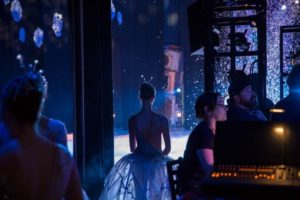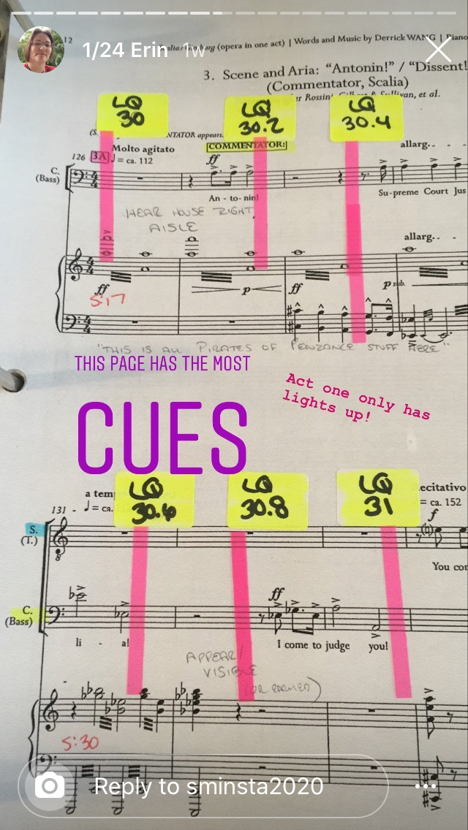
If you are a lighting designer, I have a small request on behalf of all the stage managers who will call your shows. It really can be a simple shift, but can make a WORLD of difference to your stage managers.
Please refrain from using only odd numbers for your cues.
For those who aren’t quite sure what I’m talking about, I’ll expand.
It is very common for lighting designers to skip numbers when first creating cues, so that they have wiggle room to go back and add in additional cues. There are many reasons for this – an actor walking into a dark space we hadn’t anticipated during lightwalking*, a subtle shift in mood that can give it that extra perfection, or realizing an actor moves partway through a sequence, stops, then continues, so you break it up into two looks. That is fine. What numbers lighting designers use is pretty much their own choice with digital boards these days. Some skip by twos, some by fives. If you’re teching something like a dance concert out of order, each dance piece may be given a certain section of numbers, so the third piece on the run order might start teching at Light Cue 300 (LQ 300 in my script/score), the fifth in the 500s, regardless of which one shows up at tech first. Again, not a problem.
Frankly, I get a little nervous if someone gives me preliminary cues that are 1, 2, 3, 4, 5….it means I’m likely to have a “point” cue or many by the time we open. That cue needed between 3 and 4 is created as 3.5. Not a problem. But if you need three cues in there, I’ve now got 3.1, 3.5 and 3.7…not ideal, still doable.
Here’s where my brain goes wonky:
LQ 1 – GO
LQ 3 – GO
LQ 5 – GO
LQ 7 – GO
LQ 9 – GO
LQ 11 – GO
Edit, because people have wondered: I say “Lights 5,” etc…I don’t say “Light Cue 5”. And I certainly don’t say L-X or Electrics, though I know many do. That’s more syllables I don’t want to deal with. Continued edit: I say Rail usually, not Flies, and I rarely call Mics. If someone needs me calling Mics, they probably moreso need me to name the characters specifically, rather than Mic numbers anyway.
The first time I had issues with this, I couldn’t figure out why my brain wasn’t quite firing right. And then it dawned on me. Odd numbers. Say it with me, “2, 4, 6, 8, who do we appreciate?” The next two numbers in the sequence? 10 and 12. They are all ONE-SYLLABLE words!
Now, say these out loud: “One, three, five, sev-en, nine, e-lev-en, thirteen…” And you’re going to keep getting another “sev-en” every five cues.
When in your life do you count out loud by odd numbers? You don’t. Or at least, I don’t. I can do five-ten-fifteen-twenty, no problem. I can skip by tens, easy. I count coins and paper bills (remember those?) both of those ways. I don’t count anything by twos, starting with odds. And my brain isn’t overly comfortable doing that in a show.

This is an eye-opening thought to many stage managers and lighting designers, including conversations I’ve had this week. Lighting designers rarely have to say the numbers out loud in sequence. Some of them also are only used to designing for stage managers who (in lower budget productions) push their own GO button – they’ve likely never thought about the difficulty either. For the two lighting designers I talked to yesterday, this is a very simple shift for them that they’re happy to make now…but agreed they had never considered before. (One I had worked with before, but he usually skips by fives, so it hadn’t come up between the two of us, personally.) A couple years ago, I had one designer who struggled with the thought when I brought it up, but partway through our season, she humored me and did it. I’m also teaching/mentoring some stage management students and during class one student realized that was exactly why she’d stumbled over a 13/31/33 tongue-twister issue this past weekend. Again, all are odd numbers, and our stage manager brains just have a harder time keeping track of which one comes next, and can more easily turn a bit dyslexic.
EDIT: Someone pointed me to a study, The odd effect and multiple meanings in English of the words “odd” and “even”. Its abstract says, “Under a variety of conditions, people take longer to make judgments about odd than about even digits and digit names.” I also found an article with the following fun subject and subtitle: How odd: we’re hard-wired to prefer even numbers; Would readers of Nineteen Eighty-Four have found Room 101 as chilling a location if George Orwell had instead named it Room 100? Granted, some articles I found says many people’s favorite number is 7…obviously, I’m an oddity there. Ha.
Oh, and I’ve heard of designers who number the cue based on the page number of the script. Obviously, you must work on much smaller shows than I usually do. Can you IMAGINE calling a musical with LQ 35.1 to 35.95 on one page? Oof. Please don’t. (My designer friend yesterday said he only does it if he’s pretty sure there will be no more than two cues on any given page, and thus not very often.)
So, as a frequent calling stage manager, I ask you: Please think about the numbering you’re assigning your cues the next time you’re designing a show. I’ll 2-4-6-8-Appreciate you!
Thank you.
Signed, every (edit: A) stage manager of yours who will call a show out loud to a board operator
Edit: Okay, not every stage manager. Some may have no problem with it, but based on the response I’ve been getting, there are quite a few of us whom this is indeed a trip-up for us. If it doesn’t matter to you, then please consider using evens or fives. And feel free to ask your stage manager, but until I posted this, many also hadn’t really thought about it at all, but went, “oh, it’s so true!” after I did. And, yes, if it’s tricky, I’ll just say “Lights GO” (or give a warning there will be three G-Os in a row or whatever). This is not my first – or second – rodeo, either. Meanwhile, we’ve once again proven there is no one way to stage manage or design lights. But if it doesn’t matter to the lighting designer, and it makes my life easier? Why not bring it up? Yes, of course, I’ll call the sevens if they’re given that way. Especially if they’re added between six and eight. 
*Lightwalking – These are technical sessions where light cues are created, but without the full cast onstage. This is particularly common in opera, when many technical rehearsals become primarily run-throughs. With so many more people, generally, onstage in opera (let alone the musicians in the orchestra), the budget can go way up if time is spent finessing the lights (and holding the rehearsal) while all those people are all there too. Separate time – often in the morning/daytime, with tech runs at night – is set aside for the director, lighting designer, and stage manager (and assistant director if there is one) to sit in a darkened theatre, and tell volunteers or others to move to various positions onstage while the lights are built around them. Invariably, these have to be tweaked a bit later when called that night with the cast. [Note to those creating the schedules…please don’t schedule lightwalking on a “cast day off”; the stage manager would like a day off, too. Or give the stage management staff the opportunity to split calls/days in order to facilitate this. Thanks.]
Here’s a Twitter post/photo when I took over the Boston Lyric Opera account during lightwalking for The Barber of Seville. You can also check out my blog post for that day with additional photos.
We’re setting light cues right now and continuing to finesse the scenery. It’s a full day for production staff, plus two rehearsal sessions later today. #BarberBLO#stagemanagerlife#stagemanagerspic.twitter.com/ZNALMIKa0P
– Boston Lyric Opera (@BostLyricOpera) October 5, 2018
**Because it’s likely to be asked – those are pink see-through flags by Daiso that I LOVE using for opera and musicals called from scores, to indicate exact beat location of a cue. I end up purchasing through eBay most of the time these days, using the search words “Daiso index 600.” And the yellow stickers are removable labels from an office supply store, which I buy white then highlight myself to whatever color I want (primarily yellow to pop off the page). You get about three chances to move the sticker during tech before they start curling up and needing to be replaced. The photo itself is from my SMInstagram takeover for the Year of the Stage Manager account, January 2020, the last show I did before “the great pause.”
